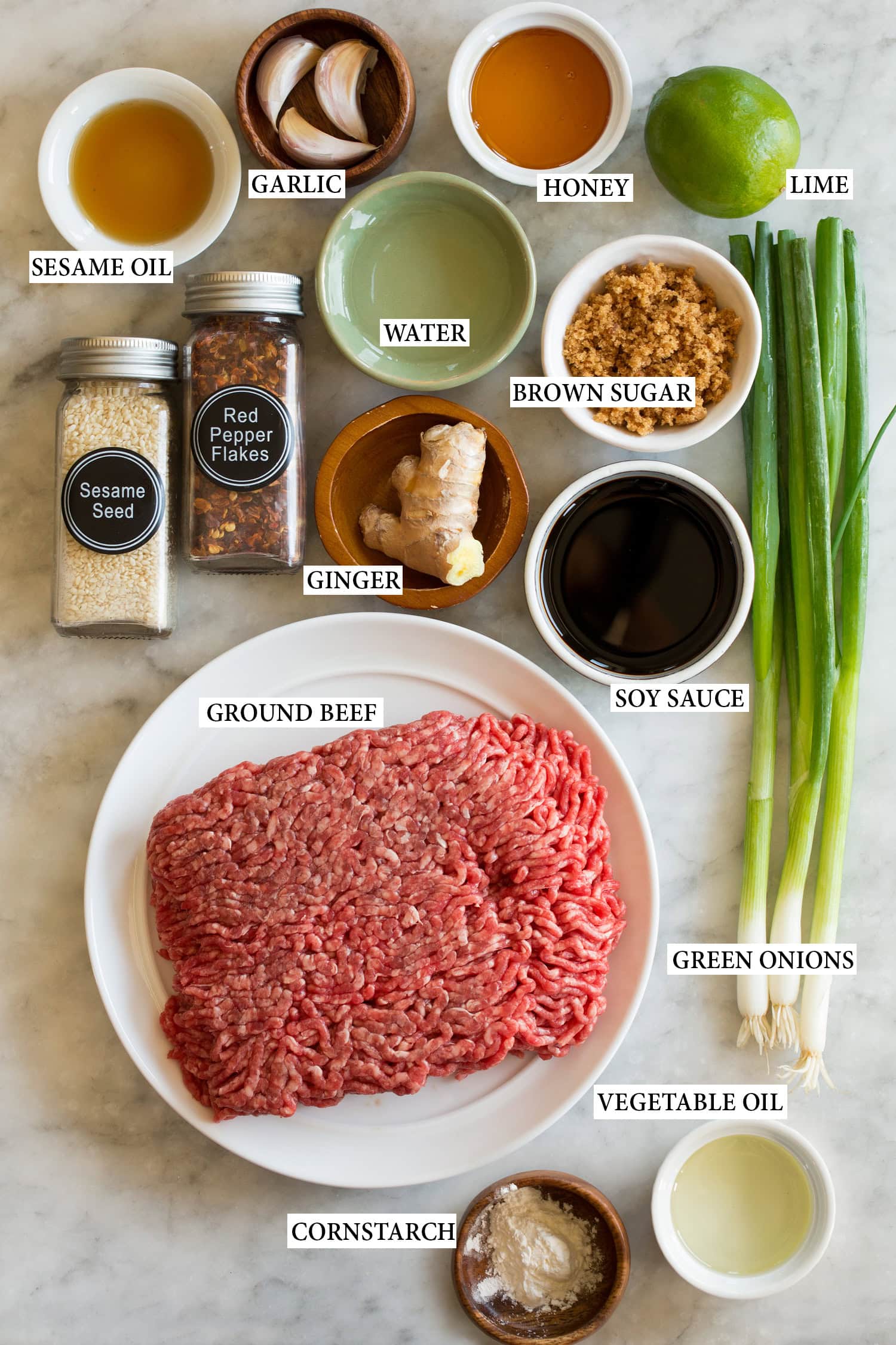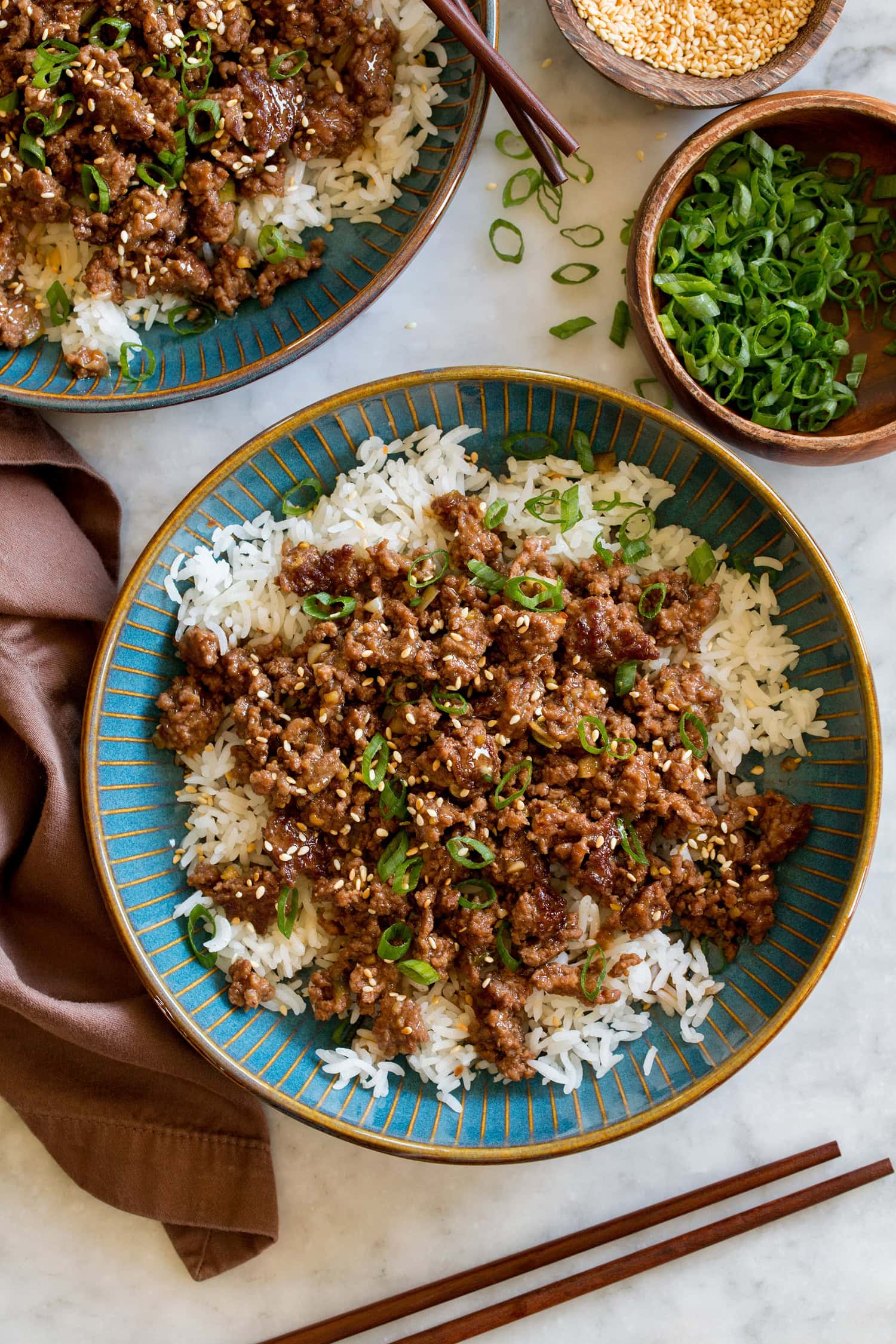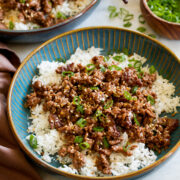Korean Beef Bowls
This post may contain affiliate links. Read our disclosure policy.
These Korean Beef Bowls are so easy to make and taste undeniably delicious! Ground beef is browned in a hot skillet and finished with a simple, yet flavorful sauce. It’s an undemanding recipe worthy of the weeknight dinner rotation.
Shortcut Korean Beef
Traditional Korean beef bulgogi is incredible of course, but this Korean ground beef bowl recipe is even easier (no marinating or slicing beef), faster, and it’s cheaper.
After just one bite I think you’ll completely appreciate this dish. Those sweet, salty, and umami flavors over the richness of the well browned beef are simplicity at it’s best.
Then when you pair it with fresh veggies and cozy rice and you’ve got a tempting, piled high bowl of hearty and delicious comfort food the whole family can agree on!
What to Serve with These Korean Bowls
If you are wondering what type of side to go with I recommend one or two of the following:
- Avocado, carrots or radishes
- Cucumbers or a Korean cucumber salad (pictured)
- Steamed broccoli or asparagus
- Sautéed cabbage, spinach, bell peppers or zucchini
- Kimchi
- Sunny side eggs
Want to see how to make Korean Beef Bowls? Check out this video!
Korean Beef and Rice Bowl Recipe Ingredients
- Honey and brown sugar: You can use one or the other if preferred you don’t have to use both.
- Sesame oil and vegetable oil: The sesame oil adds so much depth of flavor to the dish, it is a critical ingredient. It is the dark toasted sesame oil found in the Asian foods section of grocery stores.
- Lime: Use fresh lime for best flavor. In a pinch rice vinegar can be substituted.
- Soy sauce and water: Low sodium soy sauce is essentially just watered down soy sauce so here we just use a blend of both, then you get more out of the bottle of soy sauce this way.
- Ground beef: For best results use higher quality freshly ground beef sold in the meat trays at the butchers rather than the chubs of ground beef.
- Green onions, garlic and ginger: These aromatics add lots of freshness to the dish.
- Red pepper flakes (optional): Or you can use Korean red chili powder or cayenne pepper to taste. Another option is just to add a little Gochujang or Sriracha to taste.
- Cornstarch: This is an updated ingredient I added recently. It is optional but helps thicken the sauce beautifully.
- For serving you’ll also need cooked rice. You can use white rice, brown rice or even cauliflower “rice.”
How to Make Korean Beef Bowls
Whisk together honey, brown sugar, sesame oil, lime juice, soy sauce and water.
Heat skillet over moderately-high heat. Add oil.

Break ground beef into chunks then brown ground beef in skillet until about halfway cooked.
Turn beef chunks, add green onions, garlic and ginger and continue to cook until beef is cooked through while breaking up beef.


Pour in honey mixture. Let simmer, 1 minute. Thicken with the optional cornstarch slurry if desired.
Serve warm over rice with desired toppings and sides.
How to Brown Ground Beef Well without Overcooking
One thing I’ve learned about cooking over time is that browning makes everything better. And browning is key in this Korean beef bowl recipe.
Be sure to preheat the skillet it to get a good sear when the beef hits the hot skillet. And leave space between the pieces. If it’s crowded, the beef will basically just steam.
You’ll want a large skillet that’s at least 12-inches wide, a 14-inch skillet will work well too. For best results use a non-stick skillet for less sticking.
Then, very important, let the beef rest undisturbed before turning and breaking it up more. When I first started cooking, I used to stir the beef the entire time it was cooking. It always ended up kind of a strange grayish brownish color because it wasn’t getting a good sear — you really don’t need to stir much at all!
Can I Make These With Another Type of Ground Meat?
You can also make these Korean rice bowls with ground turkey, ground chicken or ground pork.
Storing and Reheating Korean Beef and Rice Bowls
- Store these in an airtight container in the fridge for up to 3 days.
- Korean beef bowls rewarm well, for best results I recommend reheating on only 50% power in the microwave so the beef doesn’t become tough.
Tips for the Best Korean Beef
- Use lean beef: Use beef that is 85% lean. It browns well without accumulating a lot of excess fat as it cooks. Once it’s browned you can even dab up some of the rendered fat with tongs and a few balled up paper towels.
- Browning is key: For premium depth of flavor brown the beef as directed in the tips above otherwise it’s lacking.
- Adjust seasonings to taste: If you want spicier bowls use more red pepper flakes, for stronger flavor increase the sesame oil, for more tang add more lime juice, for more saltiness replace 1 Tbsp of water with more soy sauce.
- Thickening the sauce: An update to this recipe is to include 1 tsp cornstarch. This is optional but just this small hint of it thickens the sauce just right.
- Mincing aromatics: Chop up the garlic and ginger very fine so you don’t get bold chunks of it throughout that detract from the dish. We want uniform flavor.
More Asian Recipes You’ll Love:
- Chicken Fried Rice
- Slow Cooker Thai Chicken Curry
- Chicken and Broccoli Stir Fry
- Chicken Yakisoba
- Slow Cooker Beef and Broccoli
- Rainbow Spring Roll Bowls
- Thai Basil Beef Bowls
Follow Easy Cooking Zone
Korean Beef Bowls
Ingredients
- 1 1/2 Tbsp honey*
- 1 1/2 Tbsp dark brown sugar (light can be substituted)
- 1 Tbsp sesame oil
- 2 tsp fresh lime juice
- 3 Tbsp soy sauce
- 2 Tbsp water
- 2 tsp vegetable oil
- 18 oz. 85% lean ground beef
- 1/3 cup chopped green onions, white and light portion
- 1 Tbsp minced fresh garlic
- 1 Tbsp peeled and minced fresh ginger
- 1/2 tsp red pepper flakes (optional)
- 1 tsp cornstarch mixed with 2 tsp water (optional)
- Chopped green onions (green portion), chopped unsalted peanuts, or toasted sesame seeds
- 2 cups cooked white or brown rice, or cauliflower "rice" (or more as desired)
Instructions
- In a small mixing bowl whisk together honey, brown sugar, sesame oil, lime juice, soy sauce and water. Set aside.
- Preheat a 12-inch non-stick skillet over moderately high heat. Crumble beef into 1-inch chunks. Add oil to skillet and beef chunks (while leaving some space between them so they brown and don't steam).
- Let beef cook undisturbed for 2 1/2 - 3 minutes until nicely browned on bottom. Sprinkle in green onions (white/light portion), garlic, ginger and optional red pepper flakes.
- Toss and break up beef and continue to cook until beef if fully browned and cooked through, about 2 - 3 minutes longer. If there's excess fat you can dab some if up using a few balled up paper towels held by tongs.
- Pour in honey mixture and reduce heat to medium. If you want the sauce thickened add cornstarch/water mixture at this point. Simmer beef with sauce, stirring frequently for about 1 minute. Taste for more soy sauce or a little salt if needed.
- Serve warm over rice, sprinkle with green onions greens, peanuts or toasted sesame seeds.
Notes
- If preferred you can use all honey or all brown sugar (3 Tbsp of one or the other) in the recipe for sweetening the sauce. You don't have to use both.
- Toppings and sides not including in nutrition. Nutrition is for beef and rice.







